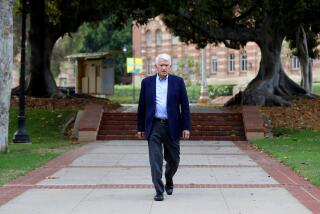Coast Panel to Consider Ocean Noise Test : Science: Researchers revise proposal to broadcast loud sounds through water to study global warming. Critics fear the experiment will harm marine life.
The state Coastal Commission will consider today whether to allow a controversial experiment to measure global warming by broadcasting loud, low-frequency sounds through the ocean off Northern California.
Scripps Institution of Oceanography, responding to widespread criticism of a plan last year to conduct the sound tests off Big Sur, has agreed to move its underwater loudspeaker to a new location off San Mateo County and pay greater attention to possible effects on whales and other marine life.
Nevertheless, critics contend that Scripps researchers are attempting to rush the project through the Coastal Commission at a meeting in Huntington Beach without giving the Northern California public an adequate opportunity to comment on its latest proposal.
“It may just sneak through for lack of public awareness,” said Anne Notthoff of the Natural Resources Defense Council, who is urging the commission to delay a decision until its June meeting in Carmel.
Scripps researchers counter that they have spent the past 14 months modifying the project and attempting to address critics’ concerns. “We are proceeding not in haste but in full compliance with federal and state laws,” project manager Andrew Forbes said.
The $35-million experiment, funded by the U.S. Department of Defense, is designed to take the ocean’s temperature by repeatedly broadcasting a 195-decibel rumble deep below the ocean’s surface. The transmissions would be picked up by underwater receivers as far away as New Zealand. Because sound travels more quickly through warmer water, oceanographers theorize that they can detect tiny changes in ocean temperature within a decade.
Although the sound would be at the lower end of the range of human hearing, people could hear or feel the vibrations of the sound waves if they were in the ocean near the sound source.
Opponents, however, are mainly concerned that the broadcasts could harm or irritate marine animals, particularly whales that communicate at the same low frequencies that the scientists would use.
Scripps originally proposed putting the loudspeaker on the ocean floor 23 miles off Big Sur and within the newly created Monterey Bay National Marine Sanctuary. But sanctuary officials refused to allow the speaker there.
Now project officials propose putting the sound source at Pioneer Seamount, 3,200 feet deep and 55 miles off Half Moon Bay. The site is well outside the sanctuary, but critics say the area is teeming with marine life, including sperm whales and elephant seals that are among the animals most likely to be affected by the noise.
Bowing to public criticism, the Scripps oceanographers have agreed to make several other changes.
Initially, they planned to study the effect of the sound on marine creatures while conducting the global warming tests--transmitting the sound for 20 minutes every four hours for two years or more.
Now, they will begin with a six-month, $4.5-million study focusing specifically on how the noise affects marine mammals. The oceanographers then would concentrate mainly on their temperature experiment, as marine biologists continue to monitor the effect on animals.
“Basically, we’ve turned the program around to give the main focus (initially) to the marine biology studies,” Forbes said. “That is people’s greatest interest and concern, and so it has become our greatest interest and concern.”
Forbes insisted that the project would be called off any time it appeared that sea creatures were being harmed.
Oceanographers believe that there is little chance of serious damage to deep-diving animals because the sound dissipates quickly as it travels through the water.
But they acknowledge that it could affect the behavior of animals within a 12-mile radius of the loudspeaker, where the noise will be 120 decibels or more. Previous studies have shown that some whales change their behavior in response to 120-decibel sounds.
To reduce the possible harm to animals, the researchers have agreed to cut back their schedule to six 20-minute broadcasts every fourth day instead of every day. Under that schedule, Forbes said, the sound would be transmitted 2% of the time.
The research team is eager to get the project approved soon so it can begin studying the effects on marine mammals this summer while a large number remain in the area.
The issue before the Coastal Commission is whether the project is likely to harm animals that travel within state waters three miles from shore. The commission also must decide whether to grant approval to run a power cable across the beach and through state waters from Pillar Point in San Mateo County to the underwater loudspeaker.
The commission’s staff has recommended approving the project because of the potential to gain new information about marine mammals, particularly how they respond to man-made noise in the ocean.
“It’s our feeling there is something in it that’s going to benefit marine mammals,” said Mark Delaplaine, a commission analyst. “We may not learn anything about global warming, but we may learn a lot about marine mammals.”
In addition to Coastal Commission permission, the experiment must win approval from the National Marine Fisheries Service for its marine mammal research and from the Monterey Bay National Marine Sanctuary to run its cable through sanctuary waters.
More to Read
Start your day right
Sign up for Essential California for news, features and recommendations from the L.A. Times and beyond in your inbox six days a week.
You may occasionally receive promotional content from the Los Angeles Times.





